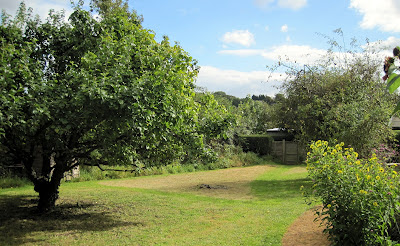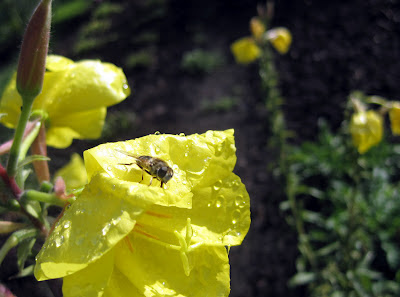Autumn seems a little early this year, the leaves aren't turning much yet but it sure has turned chilly.
Still plenty to eat of course, and will be all winter long all being well. I'm loving all the fruit - there's not many apples this year but plenty of blackberries, raspberries and grapes.
It seems like autumn for this blog too; I've been doing it for 7 years now and although there's always something new going on there's only so many ways I can describe how I sow a row a peas or plant out the cabbages. So maybe it's time to put it to rest.
Looking back I can see changes in my approach - not so much in the fruit and vegtable growing but in the flower department I've gone from growing cut flowers to growing for nectar and pollen for insects. I've always gardened organically and with wildlife in mind; being aware of all the other creatures who depend on how I manage this plot is more important to me now than ever, for them and for all the generations to come.
Sunday 30 September 2012
Winter larder
I've got potatoes in store and peas in the freezer; the brussels sprouts are starting to fill out and they'll be plenty of leeks and carrots too:
And what would I do without kale, the plant that keeps on giving:
And what would I do without kale, the plant that keeps on giving:
Meadow grass management
I've cut back the meadow grass in the orchard so it looks much bigger all of a sudden. I'll keep it short now so that the finer grasses and wildflowers can get off to a good start next spring. I'm also planning to scarify some areas and sow some yellow rattle.
Carnations
This is the only cut flower I grow these days - they've been later than usual this year after the poor summer but worth waiting for.
Bees and butterflies
I'm proud to say I've more flowers than ever this year to keep the bees and butterflies supplied with nectar during this critical late part of the season. The queen bumblebees are busy feeding up prior to hibernation and there are still plenty of carder bees about too.
During sunny times there's still butterflies about - plenty of whites and also small tortoiseshells, red admirals, speckled woods and commas.
During sunny times there's still butterflies about - plenty of whites and also small tortoiseshells, red admirals, speckled woods and commas.
Saturday 25 August 2012
Getting gappy
It's that time of year when gaps start appearing on the plot as crops are harvested. I mulch the bare soil with compost or fork in chicken pellets depending on what I'll be doing with it next. I'll also be sowing green manures in some of the spaces which won't be being used over the winter.
Still plenty to eat - peas and beans, potatoes, carrots, cabbage, tomatoes, rocket, herbs - and fruit - raspberries, blackberries and the first plums and grapes.
Looking ahead I've been sowing mizuna, leaf beet, Chinese mustard and spring cabbage. And in the flower department foxgloves and larkspur.
These days, as you may have gathered, I'm more and more interested in making sure the plot is of use to wildlife, so I'm devoting more space to flowers for our bees and butterflies.
These ones are new this year:
Still plenty to eat - peas and beans, potatoes, carrots, cabbage, tomatoes, rocket, herbs - and fruit - raspberries, blackberries and the first plums and grapes.
Looking ahead I've been sowing mizuna, leaf beet, Chinese mustard and spring cabbage. And in the flower department foxgloves and larkspur.
These days, as you may have gathered, I'm more and more interested in making sure the plot is of use to wildlife, so I'm devoting more space to flowers for our bees and butterflies.
These ones are new this year:
Aster Frikartii Monch
Catananche Coerulea (Cupid's Dart) - grown from seed and just starting to flower.
Scabiosa Beaujolais Bonnets - also grown from seed and just starting to flower.
Fruit
The top fruit hasn't done at all well this year - the apples, pears and plums all suffered through there're not being many pollinators about back in the cold and wet at blossom time. The only exception has been the little cherry plums which were blossoming during the heatwave in March. The blackbirds and thrushes carry most of them away but it's not as though I can eat them all. And the trees are not completely bare; having less helps me appreciate what I have got all the more. How right on is that?
With the exception of the gooseberries the soft fruit have been as abundant as ever. The summer raspberries have given way to the autumn crop, the grapes are about ready and the wild blackberries never have a problem fruiting - and their flowers are so useful for the bees and butterflies.
With the exception of the gooseberries the soft fruit have been as abundant as ever. The summer raspberries have given way to the autumn crop, the grapes are about ready and the wild blackberries never have a problem fruiting - and their flowers are so useful for the bees and butterflies.
Holly blue on blackberry flower
Grapes ready to nibble
Labels:
Apples,
Blackberries,
Cherry plum,
Gooseberries,
Pears,
Plums,
Raspberries
Friday 24 August 2012
Peas and beans
Harvested the last of the maincrop peas today; I've been freezing most of them as I now have plenty of beans - runners, climbing French and the wonderful Egyptian pea bean. This last one always crops well in either drought or wet; it's been doing well for me from saved seed for several years now.
Maincrop potatoes
These are a bit disappointing this year, but hardly surprising given the conditions we've had. I cut the leaves off at the first signs of blight about a month ago so they're on the small size, and at least half are affected by wireworm. I'll store them in trays rather than sacks so that I can keep an eye on them over the coming weeks and months. Still plenty to keep me going so at least I won't starve.
Nicotiana mutabilis
These have been the surprise hit of the year. I'd grown them from seed under glass and after the meadow mix failed to germinate I put them in in their place. They sat and sulked through the rain and somehow survived the attentions of all the slugs; they must have been putting down good roots because in the last month they've thrown up all these flowers up to 2 metres high. I always used to grow sylvestris but found out that British moths, unlike in their South American cousins, are unable to get at the nectar at the base of their long tubular flowers. Not so mutabilis, which is also enjoyed by the carder bees, and even the smaller honey bees squeeze their way into the flowers.
More flowers for bees and butterflies
Corn marigold
Field poppy
Rose campion
Marjoram
Verbena
Eryngium "Miss Wilmot's Ghost"
Cosmos "Candy Stripe"
Aster
Echinacea purpurea
Verbena bonariensis
Sunday 5 August 2012
August
August and the climax of the growing season. We now have tomatoes and runner and climbing French beans to go with our our peas, potatoes, cabbages, garlic, carrots and lettuce. The summer raspberries have given way to the autumn ones and today I ate the first blackberry. The flowers look pretty too.
Cabbages
On to the next patch now; it's a miracle these have survived this year with all the pests they've had to deal with. They might look pretty ropey but have good hearts - a bit like some allotment gardeners.
Brussels and broccoli
These too had a difficult start - being stunted early on by the flea beetle - but are coming along now.
Saturday 4 August 2012
Flowers and bees and stuff
Dahlia
Sunflower
Nicotiana mutabilis - good for moths
Verbena bonairiensis - good for butterflies
Gatekeeper
Shield bug on phlox
Honeybee on marjoram
Ragwort
Ragwort seems to get a bad press - ramped up by the British Horse Society - and it is toxic if eaten in large amounts by horses, but only if they eat kilos of the stuff. And as I'm not allowed to keep livestock on my plot this doesn't concern me unduly. In fact there are a lot of myths about ragwort as pointed out on this site. Ragwort is not toxic if handled by humans. Bees and hoverflies enjoy the flowers of this native wildflower and there are many other species which require its nectar and pollen. It is often a major and important resource
for many declining species - there are at least thirty species of invertebrates which are totally dependent on ragwort
as a food source, including the caterpillar of the funky cinnabar moth. So be nice to ragwort.
Sunday 22 July 2012
Summer at last
At last the jet stream seems to have finished its wobble and pulled itself together. Not that the plot has suffered so very much all things considered.
The peas have been doing brilliantly although the runner beans didn't take off too well. The new potatoes have done well - I noticed the first signs of blight so have whipped the foliage off. The cabbages have been on the small side after an initial onslaught by the flea beetle and then the ravages of slugs and snails but I've been managing to eat one every day for the past couple of weeks so can't complain really. The brussels and broccoli are coming along nicely and the leeks are getting away. The raspberries did well although the gooseberry crop has been poor. The only real disappointment has been the carrots - the summer row is about half the normal number and size and the autumn/winter ones just haven't germinated in the wet weather - I've resown them for the third time yesterday so fingers crossed. In the salad department the red lollo rosso have been fine - I don't know whether the slugs ignore them because of the colour or the crinkly leaves - and the wild rocket has been filling up my sandwiches too.
All in all not such a bad result so far - and now at last we can enjoy the summer.
The peas have been doing brilliantly although the runner beans didn't take off too well. The new potatoes have done well - I noticed the first signs of blight so have whipped the foliage off. The cabbages have been on the small side after an initial onslaught by the flea beetle and then the ravages of slugs and snails but I've been managing to eat one every day for the past couple of weeks so can't complain really. The brussels and broccoli are coming along nicely and the leeks are getting away. The raspberries did well although the gooseberry crop has been poor. The only real disappointment has been the carrots - the summer row is about half the normal number and size and the autumn/winter ones just haven't germinated in the wet weather - I've resown them for the third time yesterday so fingers crossed. In the salad department the red lollo rosso have been fine - I don't know whether the slugs ignore them because of the colour or the crinkly leaves - and the wild rocket has been filling up my sandwiches too.
All in all not such a bad result so far - and now at last we can enjoy the summer.
Subscribe to:
Posts (Atom)

















































